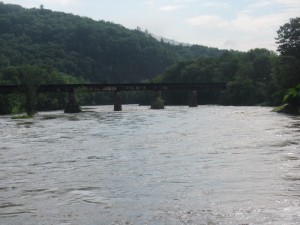The end of the ski season always leaves a void. It can put you in a bad mood or make you depressed unless you can find something to fill the void! I don’t know for a fact, but I’m guessing that may be what inspired William “Toby” Dills to start the Winooski River Raft Race in the late 1960s. Dills was a student at UVM and a member of the Outing Club. He talked the club into sponsoring a raft race on the Winooski in late April during the spring run-off. The only regulation was that all rafts had to be homemade.
 The race began just below the Bolton Dam and ended in Jonesville. The highlight of the course was the rapids around the railroad bridge which proved to be a test for both the homemade rafts and their crews.
The race began just below the Bolton Dam and ended in Jonesville. The highlight of the course was the rapids around the railroad bridge which proved to be a test for both the homemade rafts and their crews.
The race was initially intended for UVM students, but the event attracted outside attention so entries were opened to the public. The race’s popularity grew so quickly that in subsequent years the Outing Club had to limit entries to 75 rafts.
The increased participants meant an increase in spectators which led to traffic problems. River Road which runs along the south side of the Winooski river was made one-way on race day from Waterbury to Jonesville. State police had to keep people from parking in the breakdown lane of I89 south which offered a great view of the mayhem around the railroad bridge.
In 1972 my skiing buddies and I were drawn to the race as a way to continue the camaraderie we all felt from the ski season. We designed and engineered our raft using 55 gallon drums for flotation. I say “engineered” because our team did have several engineers. We were able to estimate the weight of the raft and crew to calculate how many drums we would need for adequate flotation. This was a step neglected by many teams who found when they launched their rafts that they couldn’t support their entire crew!
While I’m on the topic of flotation, the other popular choice for flotation was Styrofoam. Styrofoam is much lighter than 55 gallon drums which made transporting and assembling a lot easier. However Styrofoam has an interesting property in that it can absorb water while still maintaining its flotation characteristics. The lightweight raft that could be launched by two or three people might require an army to pull it out of the water at the end of the race!
Our crew of six consisted of four rowers (who faced backwards), a helmsman steering from the back, and a spotter up front. We were all worried about the railroad bridge, however with the high water, even the rapids before the bridge proved exciting as we almost lost our helmsman overboard.
The challenge of the railroad bridge was that one of the cement pilings for the bridge split the strong current that flowed under it. You wanted to go to one side of the piling and not hit it. Hitting the piling directly could break a raft apart or the current could pin a raft against the piling usually sweeping its crew into the river.
As we approached the bridge our spotter kept reporting that we looked good and were going to miss the bridge. Then at the penultimate moment suddenly he said: “we’re going to hit!” The steel drums striking the concrete sounded like an out-of-tune Jamaican steel band! Luckily we hit the piling with a glancing blow that simply spun the raft around and sent us backwards under the bridge.
A raft immediately behind us was not as lucky. It hit the piling squarely and the current pushed it up the piling, breaking the raft apart and dumping its crew in the cold water. We actually retrieved one of its crew from the freezing water and pulled him aboard our raft. As it turned out he had imbibed enough alcohol that it apparently acted like antifreeze. He didn’t seem to be bothered by the cold and, in fact, I’m not sure he even knew he’d been in the water!
We didn’t win, but we did finish with our raft and crew intact and without having done any swimming. We raced again the following year, but the water was lower and the bridge wasn’t nearly as exciting.
The race was discontinued in 1975. Despite the fact that in its 8 year history no one had been seriously injured, the risk and logistics became too much. There was also the matter of the amount of junk left in the river which ranged from beer cans to destroyed rafts.
Greg Dirmaier and his wife Suzanne contributed to this column. Suzanne actually worked as a volunteer on the raft race for the UVM Outing Club. We collectively dug up the data to confirm 1975 as the final year.
This brings another season of RetroSki to a close. Thanks to all who read the column and particularly to those who have answered the trivia questions. I look forward to next season!

June 30, 2017 at 5:53 pm
I belonged to the UVM Outing Club at that time and participated in the raft race one year. I remember Toby, he was great. We had an all women’s team and I believe our raft was made of barrels. It was a bit scary but a lot of fun. Would love to do it again!
November 16, 2018 at 3:53 pm
I was a student at St. Mike’s back in ’72 I was an unofficial entry in the race. I went down the river on my surfboard trying not to hit rocks and other obstructions… It was a riot!!!